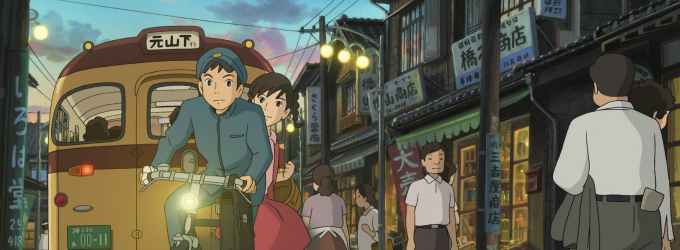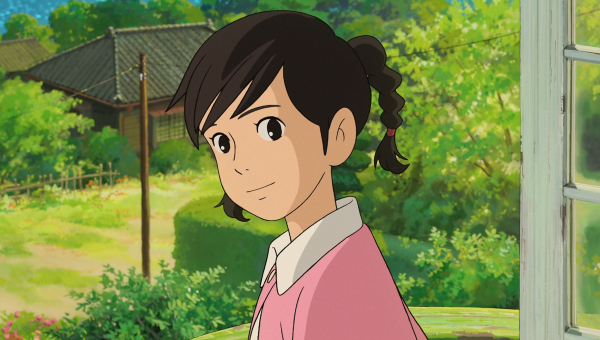
Heart-warming, like a trip going back to childhood, or your first romance. Released in summer 2011 in Japan, FROM UP ON POPPY HILL, directed by animation master Hayao Miyazaki’s son Gorō, finally opened at UK cinemas on the 2nd of August. It took almost two years for the film to travel the Atlantic, but it was worth the wait. Many Studio Ghibli films have their own original stories, but FROM UP ON POPPY HILL is an adaptation of a 1980s shōjo manga series of the same title. Although Gorō Miyazaki has full artistic control of the film, his 72-year-old father was involved in script-writing and poster design – it seems Hayao Miazaki never wants to retire.
Studio Ghibli is not just about producing mythical animation full of endless imagination. Set in 1960s Japan, the narrative of FROM UP ON POPPY HILL is not as dramatic as PRINCESS MONONOKE, SPIRITED AWAY or PONYO, but it warms the audience’s heart in its own way. Umi (meaning ocean in Japanese) is a 16 year-old high-school girl, and she lives by the sea at her grandparents’ manor on top of a poppy hill. Apart from going to school, she is also responsible for looking after her younger siblings and the guests at the manor. Although her life is very busy, she raises the signal flags every day, in memory of her dead sailor father. Shun is a member of the school journalism club, and after a few meetings with Umi, they fall in love. Their love grows stronger throughout their participation in a protest against an old school building being demolished.
It is not only about yearning for the past, but bringing the past alive again …
Studio Ghibli is famous for its creation of spirits. In the Ghibli world, every creature maintains a soul. What Ghibli is also keen on, is nostalgia. It is not only about yearning for the past, but bringing the past alive again in vision, sound and narrative, to remind us of the importance of history and memories. During the 1960s, new thought in Japan suggested that the country should move forward and to be modernized. Therefore, a lot of the old buildings were destroyed. However, if people had tried harder to protect them, perhaps the case could be different. In order to save the old architecture, Umi encourages her fellow female students to get involved in the protest, by helping to clean up and refurbish the building. The students’ action touches the school sponsor deeply, and we learn that he also has a heart of child, appreciating the energy and innocence of youth.
Later, there is a narrative twist which suggests that Shun and Umi might be siblings. Both characters repress their passionate love towards each other because of the myth, but how can they stop loving each other after what they have been through and achieved together?

Cleaning up an old dusty building might not seem as exciting as meeting a giant rabbit-like spirit, adventuring with a moving castle, discovering a floating city, or experiencing how a goldfish turns into a little girl; but FROM UP ON POPPY HILL touches the most innocent part of our heart, and shows us that small events in life can mean a lot, especially those in our teenage years that we forget as busy adults. Those who think it is not as exciting as SPIRITED AWAY should know that Ghibli’s ethos is about producing excitement, but at the same time, peace.
… a film about […] protecting history, and celebrating the energy and innocence of youth.
Following the Ghibli artistic tradition, FROM UP ON POPPY HILL uses hand-drawn animation techniques, but it is possible that the artists also applied some kind of computer special-effects. Throughout the film, there seems to be a light layer of sepia velvet which enacts a retro effect on the colour. This is most obvious in the evening scene when Shun takes Umi on a bike ride surrounded by gentle streetlights. Another great thing about the drawing is the way that Gorō Miyazaki focuses on and emphasizes the tiny details of a character’s expressions. The details of a smile, a drop of tear, and a light blush make the characters ever alive and moving.
FROM UP ON POPPY HILL is a film about missing the dead, maintaining their spirit by remembering them, protecting history, and celebrating the energy and innocence of youth. The film features a famous Japanese pop song “Ue o Muite Arukō” as its soundtrack, though the song is more commonly known as “Sukiyaki” in the West. Hopefully, through the popularity of the film, this classic Japanese pop song will become a hit again like it did in 1961. The old aesthetics only die if we stop talking about them – they remain alive as long as we remember and appreciate them.
httpvh://youtu.be/GAZUzbJYRNI

